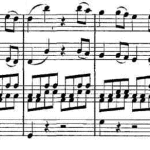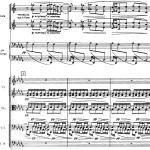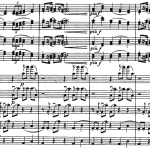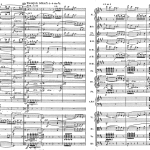Reading a score requires certain skills, notably knowledge about instruments and their respective volume or sound power, how to read transposing parts, understanding the layout of the score, etc. Furthermore, it is vitally important to be able to weight and group the numerous data of a score into separate interacting wholes. Regarding everything as one vast entity or, conversely, considering every single note to represent important information, will in both cases obstruct a meaningful overview. And that is exactly what reading a score is about: creating an overview, having an eye for elements with certain shared features, elements that complement one another and display common functions or characteristics. Score reading begins the moment one becomes aware of identities and similarities between specific elements that together constitute a larger entity, possibly in the form of a melody, two or more simultaneous melodies, an accompaniment, a foreground, a background, etc. Thus, score reading entails among other things the ability to group different types of information and elements into segments. Here the term is used in its most comprehensive sense: a whole that is part of a larger whole. Consequently, a segment may consist of several different elements.
The following is a series of examples showing how various common features naturally divide the many types of information on a page into groups, each forming a separate part of the whole, or segment. Decoding a score in this way and assessing the importance of the different parts and the relationship between them will from here on be referred to as segment analysis.
Figure 30 · Mozart, Symphony No. 40, 1st movement, m. 1
An overview of the above example is easily established: 1st and 2nd violins present a theme, the other instruments contribute with an accompaniment. Although this may seem self-evident, the example shows how similarity, function as well as character must be taken into account to determine whether a single piece of information belongs to a certain segment. The fact that both violin sections play the same melody (albeit an octave apart) links them together as a segment, of course. Elements or lines that share a common character or function are linked correspondingly. The undulating chords in the violas (played divisi) harmonize the melody using a typical accompaniment pattern, whereas cello and bass provide the harmonic foundation. Together they constitute a segment of their own.
Figure 31 · Debussy, La mer, 1st movement, number 3, m. 1
Well over one hundred years separate Mozart from Debussy, a fact that is evident in both the character of the melody and the accompaniment, but a segment analysis will arrive at precisely the same structural result. Here, too, the melody is played in octaves, only the instruments differ. The accompaniment is once again the sum of several parts, and just as easily identified: a chord is set into rocking motion by the 2nd violins and violas, while the cellos provide a fluid and carefully worked out bass foundation, partly doubled by the harp.
Although the bass voice at first glance seems to be part of the accompaniment, it could just as easily be regarded as an independent element (triplets are implied in the cellos, but not explicitly indicated). Any segment analysis involves a certain degree of judgment, an overall assessment of the different elements with regard to function, character and musical significance. It is one of a number of tools that can provide a better understanding of the score, not a measuring device.
Figure 32 · Tchaikovsky, Symphony No. 6 (“Pathétique”), 2nd movement, m. 25
This example is a natural extension of the previous two, once again illustrating the structure of melody and accompaniment. But here the structure is considerably more complex. Not only has the melodic line in octaves been equipped with doublings in thirds, but has also been combined with its own inversion! The accompaniment consists essentially of a single note that ascends through four octaves like a pedal point spread out over the full range of the orchestra.
This not only raises questions about the criteria used to define segments, but – once again – how to distinguish between orchestration and musical content as such. Does the inversion represent a combination of two melodies or should we consider it to be a somewhat unusual type of doubling? Such considerations become vital when several different segments are involved, for instance when two or more melodies occur at the same time, possibly each with its own accompaniment. Or when an accompaniment consists of several uniquely identifiable segments.
Figure 33 · Strauss, Sinfonia Domestica, number 29
At the double bar (with upbeat) we are presented with a melodic main voice played by oboe d’amore + cor anglais, two horns, 1st violins + violas. Furthermore, Strauss adds a contrasting second melody in the high woodwinds. In the following bar, Bb clarinets and 2nd violins seem to introduce yet another melody, which however is almost immediately absorbed by the main melody (a kind of “pseudo counterpoint” extremely typical of Strauss). The remaining horns + bassoons + lower strings produce a pulsating choral accompaniment. Note the combined simple and compound duple meter.
Segment analysis is an indispensable part of score study, and archetypal segments such as melody and accompaniment naturally occur with particular frequency. Assessing the function of a segment as part of the whole depends on its relative prominence in relationship to other segments. As mentioned earlier, segment analysis also takes into account features such as similarity in outline and structure of movement, correlation in register, resemblance in character or affiliation with certain musical functions.
Segment analysis will be discussed in more detail in the chapter about dynamics and balance.
· · ·
Next · Chapter 4 · Unisono and Doubling



